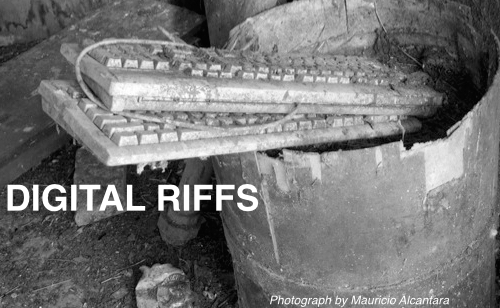skip to main |
skip to sidebar

Mark Weiser was the Chief Technology Officer at the Rank Xerox Palo Alto Research Center (PARC) from 1996-1999. PARC had of course during the 1960s and 1970s been the place where many of the features we associate with personal computing were developed. Weiser had a vision of something which went further - a world where we are surrounded by technollogical devices which help shape our life silently and without complex interactions. Weiser called this 'ubiquitous computing' and described his vision in an article 'The Computer for the 21st Century' in the Scientific American in 1991. And of course Weiser's vision is very much the world we see taking shape today - of mobile phones which are powerful small computers, domestic devices controlled by chips, self-navigating cars, an internet of things.
Weiser's work is described in the enthralling book by Phil Dourish and Genevieve Bell, Divining a Digital Future: Mess of Mythology in Ubiquitous Computing. Weiser sadly died on cancer in 1999 but his website www.ubiq.com provides a record of his ideas and personality - itself an interesting example of the need to preserve websites as historical documents.
Among the documents archived on Weiser's site are a series of slides (35mm. slides - these were the days before data projectors were commonplace) from a talk called 'Building Invisible Interfaces' given by him in 1994. The whole lecture is compelling, but perhaps particularly intriguing for those working in the digital humanities is Slide No. 10:
'start from arts and humanities' is a wonderful message. Weiser's message was, as described by Dourish and Bell, a heady one: 'Weiser hoped that future research in ubicomp would be thoroughly grounded in postmodern analysis and feminist critical theory'. (p. 16) Maybe Weiser's vision of computer science research which is framed by a powerful engagement with cultural theory anticipates what Digital Humanties is becoming.
About Me

- Andrew Prescott
- I am Professor of Digital Humanities at the University of Glasgow and Theme Leader Fellow for the 'Digital Transformations' strategic theme of the Arts and Humanities Research Council. I tweet as @ajprescott.
This blog is a riff on digital humanities. A riff is a repeated phrase in music, used by analogy to describe a improvisation or commentary. In the 16th century, the word 'riff' meant a rift; Speed describes riffs in the earth shooting out flames. The poet Jeffrey Robinson points out that riff perhaps derives from riffle, to make rough.
Maybe we need to explore these other meanings of riff in thinking about digital humanities, and seek out rough and broken ground in the digital terrain.
Popular Posts
-
One of the distinctive features of many London squares and terraces are the black metal stubs on house walls and steps, where metal fence...
-
This is the text of a keynote lecture to the conference at Leicester University on 11 January 2013 marking the launch of Manuscripts Onl...
-
This lecture was given to the Digital Humanities Summer School, Oxford University, 6 July 2012. During my time in charge of t...
-
A colleague drew my attention to NicolaOsborne’s liveblog of the very interesting event at the University of Edinburgh on 24 Feb...
Powered by Blogger.
9 August 2013
"Start from Arts and Humanities"
Mark Weiser was the Chief Technology Officer at the Rank Xerox Palo Alto Research Center (PARC) from 1996-1999. PARC had of course during the 1960s and 1970s been the place where many of the features we associate with personal computing were developed. Weiser had a vision of something which went further - a world where we are surrounded by technollogical devices which help shape our life silently and without complex interactions. Weiser called this 'ubiquitous computing' and described his vision in an article 'The Computer for the 21st Century' in the Scientific American in 1991. And of course Weiser's vision is very much the world we see taking shape today - of mobile phones which are powerful small computers, domestic devices controlled by chips, self-navigating cars, an internet of things.
Weiser's work is described in the enthralling book by Phil Dourish and Genevieve Bell, Divining a Digital Future: Mess of Mythology in Ubiquitous Computing. Weiser sadly died on cancer in 1999 but his website www.ubiq.com provides a record of his ideas and personality - itself an interesting example of the need to preserve websites as historical documents.
Among the documents archived on Weiser's site are a series of slides (35mm. slides - these were the days before data projectors were commonplace) from a talk called 'Building Invisible Interfaces' given by him in 1994. The whole lecture is compelling, but perhaps particularly intriguing for those working in the digital humanities is Slide No. 10:
'start from arts and humanities' is a wonderful message. Weiser's message was, as described by Dourish and Bell, a heady one: 'Weiser hoped that future research in ubicomp would be thoroughly grounded in postmodern analysis and feminist critical theory'. (p. 16) Maybe Weiser's vision of computer science research which is framed by a powerful engagement with cultural theory anticipates what Digital Humanties is becoming.
Subscribe to:
Post Comments (Atom)
Search these riffs
Labels
access
advocacy
alt-ac
archives
battle of the books
bibliography
big data
biosciences
british library
catalogues
Charles Babbage
coding
conductive ink
culture
curstorship
data
defining DH
densitometry
digital arts
Digital curation
digital history
digitisation
DNA
ethnic
family history
freemasonry
GIS
globalisation
hardware
humanities
industrial revolution
infrastructure
innovation
interdisciplinarity
learned societies
libraries
library history
lines
linked data
London
making
manuscripts
maps
materialities
medicine
memory
metadata
MLA
mortality
paywalls
pedagogy
poetry
projects
quantification
queer
REF
robin alston
romantic
scholarly communication
scholarship
science
sequacious
sound
space
spatial humanities
theory
ubiquitous computing
wales
women
Copyright © 2011 Digital Riffs. All Rights Reserved.
Magazine Basic theme designed by Themes by bavotasan.com. Bloggerized by Free Blogger Template.
Powered by Blogger.
Magazine Basic theme designed by Themes by bavotasan.com. Bloggerized by Free Blogger Template.
Powered by Blogger.







0 comments:
Post a Comment